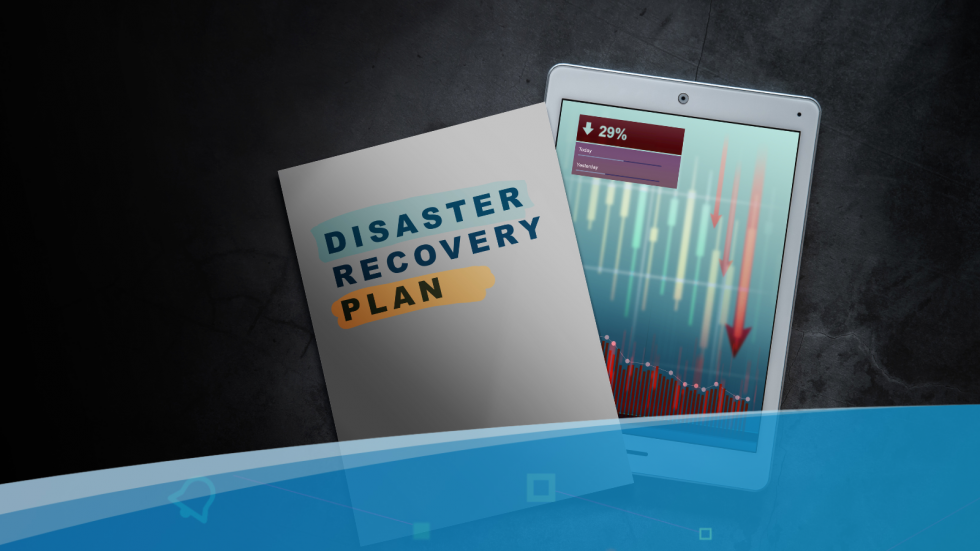Published on 4 August 2021
When disaster strikes, having a well-prepared Disaster Recovery (DR) Plan could mean the difference between getting your business back on its feet quickly and facing prolonged downtime. Yet, many businesses know the importance of a DR Plan but are unsure how to create one or what to include. Don’t worry, this guide will walk you through everything you need to know.

A Disaster Recovery Plan is a formal document outlining the procedures and processes your organisation will follow to recover critical systems and operations after a disruption. This could include anything from a cyberattack or power outage to natural disasters such as floods or fires.
The primary aim is to minimise downtime, prevent data loss, and ensure business continuity as seamlessly as possible. A robust disaster recovery Plan identifies risks, assigns responsibilities, and includes detailed action steps for recovery.
A well-designed Disaster Recovery (DR) Plan is the backbone of your business’s ability to weather disruptions and recover effectively. Here’s how it aligns with your goals:
Did you know businesses lose an average of $9,000 (£7,500) per minute during downtime? Imagine the impact on your bottom line if operations halt for hours or even days. A DR Plan prioritises speedy recovery, ensuring you can restore critical systems and resume operations without prolonged interruptions.
Data loss is alarmingly common, 76% of organisations have experienced significant data loss, and nearly half have dealt with permanent loss. A DR Plan safeguards your data by incorporating strategies like regular backups and redundancy. This ensures you can retrieve crucial information even after catastrophic incidents.
Continuity isn’t just about getting back online; it’s about keeping the wheels turning when disaster strikes. Statistics show that 96% of IT organisations have encountered outages recently. A strong DR Plan keeps essential business functions running, maintaining service delivery and internal processes.
Disasters can shake customer confidence. Whether it’s a data breach or system failure, a poorly handled incident can erode trust. A DR Plan includes strategies for transparent communication, demonstrating reliability and professionalism even under pressure.
Failing to comply with data protection and continuity regulations can result in hefty fines and legal repercussions. DR Plans ensure your business stays on the right side of the law by addressing regulatory requirements proactively.

Creating a Disaster Recovery (DR) Plan isn’t just a routine task; it’s a critical strategy for ensuring your business stays operational and competitive during unforeseen challenges.
A well-prepared DR Plan allows your business to recover swiftly and resume normal operations, ensuring minimal disruption. It provides a structured approach to recovery, enabling you to stay ahead while competitors might struggle to regain their footing.
A DR Plan includes robust measures like tested backup solutions to safeguard your data. This ensures that even in the face of disasters, critical business information remains secure and accessible, reducing the risk of permanent data loss.
Unexpected downtime can lead to significant financial losses. A DR Plan helps mitigate these risks by ensuring quick recovery and reducing the likelihood of prolonged disruptions, helping to protect your cash flow and avoid unnecessary expenses.
Efficient disaster recovery demonstrates your commitment to reliability and professionalism. By maintaining operations and service delivery during challenging times, you can preserve customer confidence and build lasting loyalty.
A DR Plan might sound complex, but at its core, it’s a structured roadmap designed to guide your business through crises. Here’s how it all comes together:

The first step in creating a DR Plan is identifying potential threats that could disrupt your business operations. These threats can range from cyberattacks and hardware failures to natural disasters like floods or fires. Conducting a thorough risk assessment allows you to evaluate the likelihood and potential impact of these scenarios. This information forms the basis for designing effective recovery strategies tailored to your business’s unique vulnerabilities.
What happens if disaster strikes? Impact analysis looks at how specific incidents—like a server outage or data breach—could affect your business’s operations, revenue, and reputation. This analysis helps prioritise which systems and processes need immediate attention.
A DR Plan isn’t just about responding to incidents; it’s about having proactive measures in place. Strategies like the 3-2-1 backup rule (three copies of data, stored on two different media, with one off-site) ensure data redundancy and quick restoration. This step also includes identifying alternative workspaces or remote working solutions to maintain productivity.
Clear communication during a disaster is vital. A good DR Plan specifies who needs to be informed, what they need to know, and how that communication should happen. This reduces panic and ensures everyone is aligned on the recovery process.
A DR Plan isn’t static; it requires regular testing to identify weaknesses and adapt to changes in the business environment, such as new technologies or emerging threats. Frequent reviews and updates ensure that the plan remains relevant and effective.
Creating a comprehensive DR Plan involves several critical steps. Here’s how to get started:
Make sure you have aligned your Recovery Time Objective (RTO) and Recovery Point Objective (RPO) with your business objectives. Consider what systems and applications are essential for your business to continue operating. For example, if you receive most of your business through your website, that should be one of your top priorities if a disaster strikes. Prioritise and categorise your systems and applications in order of importance to help prevent prolonged downtime.
Consider using a grading system to do this, for instance, Gold, Silver and Bronze to help you with categorisation. Don’t forget about the dependencies required for your Gold applications to run, for example, what background software does your Gold category website need to get up and running quickly?
For everything to run smoothly in a disaster be certain that everyone involved knows what their role is. Having this set in advance prevents confusion and important tasks from being overlooked. Assigned roles will allow for smoother and faster recovery. For example in the event of a fire for everyone to safely exit the building, everyone must know their role and what responsibilities they have. Like ensuring that any important hard drives are removed from the building.
What if your office becomes uninhabitable? You need to consider where all your employees will need to be to continue their work and what kind of devices they will need. Larger businesses may have entire empty offices available if their main office becomes unusable. However, this kind of investment is not feasible for many small to medium businesses. With The Cloud, your employees will be able to work from home at short notice and still have access to all their online documents.
Decide how and when to communicate with stakeholders, customers, and the public. This will depend on the severity and visibility of the incident.
For example, a dairy supplier unable to meet delivery deadlines should inform clients immediately to allow them to make alternate arrangements.
RPO and DR Plan in place can be a big investment. It is important to consider your budget and what is most important for your business. Is your business’s data imperative to its functionality? If having the most up-to-date data is high on your priority list, it will be worth investing more in your RPO.
And finally test, test, test. The key to any good DR Plan is regular testing. This lets you see what worked, and what didn’t and make adjustments. Testing allows everyone involved to become well-practised, so if a disaster happens, everyone will be well-versed in what their role is and how to proceed. Remember to have a written document of your DR Plan and continuously update it. For example, if you add a new piece of software to your systems make sure you test this on your next DR Test and add it to your written plan.
Testing validates your plan and highlights areas for improvement. Use these strategies:
A well-crafted Disaster Recovery Plan is essential for safeguarding your business against unexpected events. By setting clear objectives, assigning roles, preparing for alternate work environments, and regularly testing your plan, you’ll ensure faster recovery and greater resilience.
Disasters are unpredictable, but your IT systems don’t have to be. At Bluebell IT, we specialise in comprehensive IT consultancy services to keep your business secure, resilient, and future-ready. Whether it’s safeguarding your data with cybersecurity measures, implementing robust disaster recovery solutions, or managing cloud migrations and networks, we’ve got you covered.
We also offer managed IT services tailored to your unique needs, ensuring seamless day-to-day operations while you focus on growing your business. But don’t just take our word for it, check out our client testimonials to see how we’ve helped businesses like yours thrive in the face of challenges.
Ready to strengthen your IT strategy? Call us today on 01908 044202 to learn more about how Bluebell IT can support your business. Let’s work together to build a resilient and secure future.

© 2025 Bluebell IT Solutions - All rights reserved
SEO and Website Design by Loop Digital